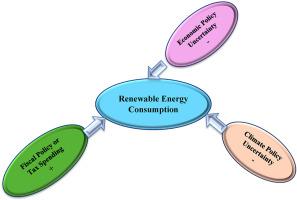建设有弹性的清洁能源转型:经济、财政和气候政策的不确定性是否有助于美国的可再生能源消费
IF 8.4
2区 环境科学与生态学
Q1 ENVIRONMENTAL SCIENCES
引用次数: 0
摘要
该研究调查了1988-2024年期间美国可再生能源消费(REC)与政策不确定性之间的动态和不对称联系,采用了带有滚动窗口和预测范围的分位数VAR (QVAR)连通性框架,并辅以多频率分位数相关性(MFQC)。动态总连通性结果表明,溢出效应具有强烈的时间和状态依赖性,在互联网泡沫、全球金融危机和2019冠状病毒病等危机期间会加剧,不利和繁荣的状态都会放大系统性传播。净连通性分析表明,财政政策(FP)和气候政策不确定性(CPU)是持续的冲击发射器,而REC、股票市场(STM)和经济政策不确定性(EPU)主要是接受者,尽管REC的角色在2010年后(特别是在2019冠状病毒疫情期间)转向传输,突显出其日益增长的系统性重要性。分位数网络图证实了这些非线性动态,CPU、FP和REC在低分位数和高分位数中都是主要的发射机,而EPU和STM吸收冲击,反映了极端状态下的脆弱性。使用MFQC的稳健性检验进一步表明,财政政策冲击在短期极端情况下影响最大,EPU在低频稳定条件下抑制可再生能源的采用,CPU持续破坏可再生能源,而工业生产(INDP)在长期支持可再生能源。总体而言,研究结果强调,可再生能源仍然对政策和宏观经济冲击高度敏感,强调需要建立可靠和稳定的政策框架,以加强抵御能力并确保可持续的清洁能源转型。本文章由计算机程序翻译,如有差异,请以英文原文为准。

Building resilient clean energy transitions: Does economic, fiscal, and climate policy uncertainties contribute to renewable energy consumption in United States
The study investigates the dynamic and asymmetric linkages between renewable energy consumption (REC) and policy uncertainties in the United States over the period 1988–2024, employing a Quantile VAR (QVAR) connectedness framework with rolling windows and forecast horizons, complemented by Multi-Frequency Quantile Correlation (MFQC). The dynamic total connectedness results reveal that spillovers are strongly time- and state-dependent, intensifying during crises such as the dot-com bubble, the global financial crisis, and COVID-19, with both adverse and exuberant states amplifying systemic transmission. Net connectedness analysis shows that fiscal policy (FP) and climate policy uncertainty (CPU) are persistent shock transmitters, while REC, the stock market (STM), and economic policy uncertainty (EPU) are mostly receivers, although REC's role shifts toward transmission after 2010, particularly during COVID-19, highlighting its growing systemic importance. Quantile network plots confirm these nonlinear dynamics, with CPU, FP, and REC emerging as dominant transmitters in both lower and upper quantiles, while EPU and STM absorb shocks, reflecting heightened vulnerability in extreme states. Robustness checks using MFQC further demonstrate that fiscal policy shocks are most influential in short-run extremes, EPU dampens renewable adoption in low-frequency stable conditions, and CPU consistently undermines renewables, while industrial production (INDP) supports REC in the long run. Overall, the findings highlight that renewable energy remains highly sensitive to policy and macroeconomic shocks, underscoring the need for credible and stable policy frameworks to strengthen resilience and ensure a sustainable clean energy transition.
求助全文
通过发布文献求助,成功后即可免费获取论文全文。
去求助
来源期刊

Journal of Environmental Management
环境科学-环境科学
CiteScore
13.70
自引率
5.70%
发文量
2477
审稿时长
84 days
期刊介绍:
The Journal of Environmental Management is a journal for the publication of peer reviewed, original research for all aspects of management and the managed use of the environment, both natural and man-made.Critical review articles are also welcome; submission of these is strongly encouraged.
 求助内容:
求助内容: 应助结果提醒方式:
应助结果提醒方式:


